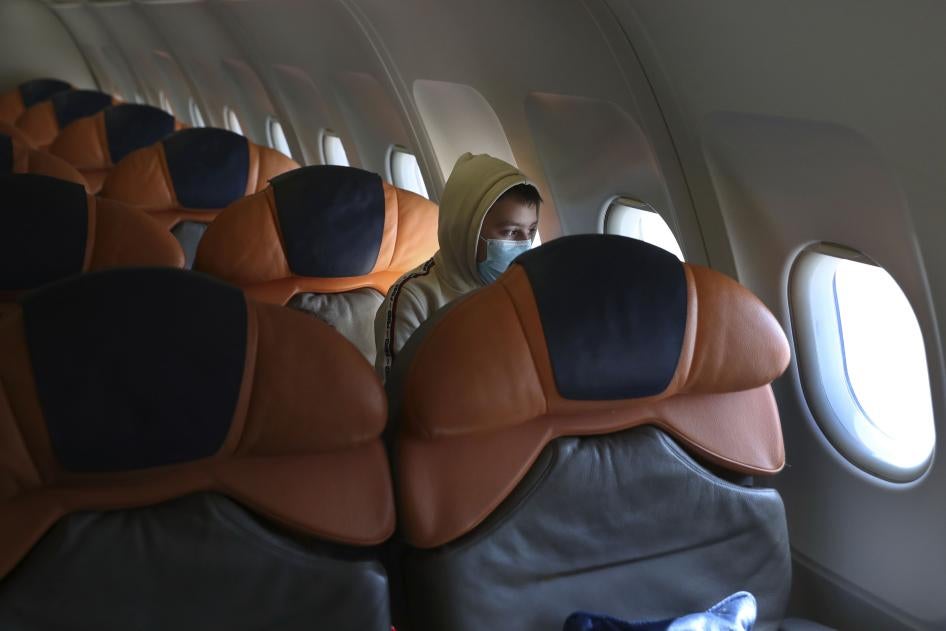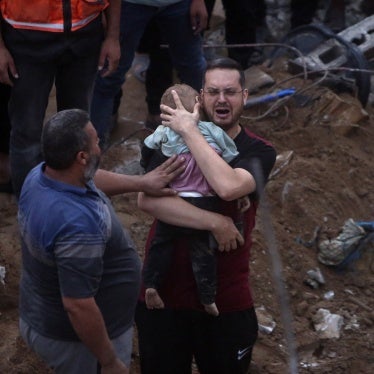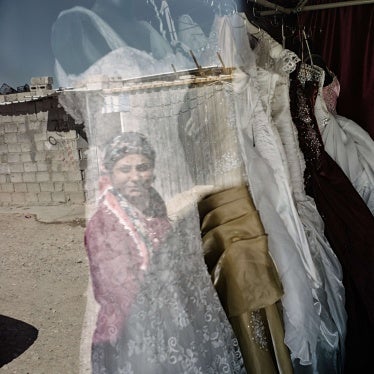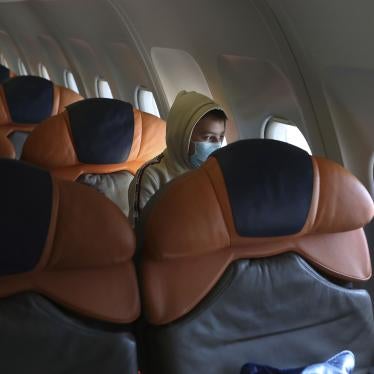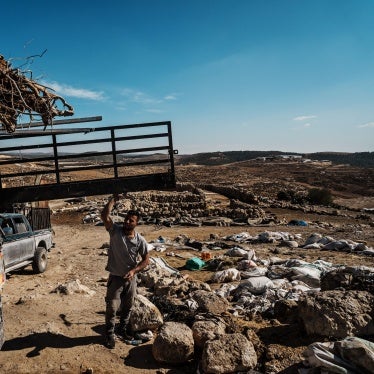Introduction
Of the nearly 42,000 foreign Islamic State (ISIS) suspects and family members from 60 countries currently detained in northeast Syria, most are children. Many were taken to Syria by parents who sought to join ISIS or live in the “caliphate.” Others were born in Syria under areas of ISIS control or in the camps where families with alleged ISIS links are detained. Nearly 80 percent of the children are under the age of 12, and far too young to have played an active role in ISIS, yet many governments refuse to take these young nationals back, citing national security concerns or fearing public backlash.
As the detention of most of the foreign nationals will soon enter its fifth year, with some held even longer, children remaining in the camps are trapped in an indefinite limbo. They are held in conditions so dire they may amount to torture, and face escalating risks of becoming victims of violence or susceptible to recruitment by ISIS. In visits to northeast Syria, we found their despair to be palpable, and in some cases, suicidal. Many United Nations, counterterrorism, and security experts warn that abandoning these children in the camps and prisons carries greater national security risks than bringing them home.
Our research at Human Rights Watch has found that many of the children detained in the camps who were subsequently repatriated or returned to their countries are reintegrating successfully. Yet, apart from Iraq, which to date has repatriated nearly 2,850 children, 35 other governments have collectively accepted the return of only about 1,600 children to date, leaving nearly 23,000 others to languish in northeast Syria. Canada has brought home only four children. Although the government agreed in January 2023 to bring home 13 more, at least 30 Canadian children remained detained at the time of writing.
Detainee Population
In March 2019, the Syrian Democratic Forces (SDF), a Kurdish-led, regional force backed by a United States-led military coalition, rounded up tens of thousands of Syrian and foreign ISIS suspects and family members as they toppled the last remnant of ISIS’s self-declared “caliphate” in northeast Syria. The SDF detained these Syrians and foreigners in camps, prisons, and makeshift detention centers, where they were already holding several thousand others for suspected ISIS links.
As of January 23, 2023, nearly 42,000 foreigners remain held in the region along with more than 23,000 Syrians. Nearly 37,000 foreign nationals are detained in al-Hol and Roj, two locked, sprawling camps primarily holding the wives, other adult female relatives, and children of male ISIS suspects. Nearly 27,000 foreigners in the camps are from neighboring Iraq, while nearly 10,000 others are from about 60 other countries. More than 60 percent of the camp detainees are children. Nearly 80 percent of the children are under the age of 12, and 30 percent are age 5 or younger. Approximately 5,000 other foreigners are held in prisons and “rehabilitation” centers, including up to several hundred children.
Conditions of Detention
Neither the children nor the adults detained in northeast Syria have been brought before a judicial authority to determine the necessity and legality of their detention, making their detention arbitrary and unlawful. Detention based solely on family ties is a form of collective punishment, which is a war crime. Governments that knowingly and significantly contribute to this abusive confinement may be complicit in the foreigners’ unlawful detention.
Human Rights Watch has visited al-Hol and Roj camps and other detention centers in northeast Syria several times since 2019, most recently in May 2022. Conditions for the children are life-threatening, deeply degrading, and in many cases, inhuman; their cumulative psychological impact may amount to torture. Medical care, clean water, and shelter, as well as education and recreation for children are grossly inadequate.
According to the Kurdish Red Crescent, at least 371 children died in 2019 in al-Hol, the larger of the two camps, many from preventable diseases or hypothermia. Children have also drowned in sewage pits, died in tent fires, and been hit and killed by water trucks. Children who have died in al-Hol and Roj come from at least 24 countries, according to media reports and data we received from the Rojava Information Center.
Several mothers in Roj told Human Rights Watch their children suffered from severe asthma, which they attributed to fumes from an adjacent oil field, but that they could not obtain sufficient oxygen or other medicine. “He can’t breathe properly,” one Canadian mother said of her 4-year-old son. “A few months ago when he had an attack he went blue.”
Some younger children attend informal preschool, but most children have no access to education and have missed out on years of schooling.
The camps have become increasingly dangerous and violent, as detainees, including many loyal to ISIS, have carried out attacks against other detainees, camp authorities, and aid workers. The UN reported that 90 people were murdered in al-Hol in 2021, and 42 from January to mid-November 2022. In November 2022, two Egyptian sisters, both under 15, were found dead in a sewage canal in al-Hol after being raped and stabbed. Mothers interviewed by Human Rights Watch said they hid their children in their tents to protect them from sexual predators, abusive camp guards, and ISIS recruiters and fighters. One Canadian mother detained in Roj camp told Human Rights Watch in May 2022, “When we were under the Islamic State, we had to find a safe place to protect our children from the bombs. Now we have to find them a safe place to protect them from other people in the camps.”
Like many women, the mother said she also needed to protect her children from increasing traumatization as the years passed by in the camps. Days earlier, she said, her young son had tried to hang himself with a tent rope.
Conditions are even worse in the prisons and makeshift detention centers where the SDF is holding up to 1,000 detainees, from about 20 countries, who are boys or who were apprehended before they turned 18. Most of the boys are ages 14 to 17, though detainees and aid workers have told Human Rights Watch that some may be as young as 12. In the prisons, overcrowding initially was so severe that many of the detainees slept shoulder to shoulder. Many imprisoned Syrian and foreign boys were initially held in cells with men.
In January 2022, ISIS attacked one prison holding about 700 boys in the city of al-Haskah, sparking a 10-day battle with SDF fighters backed by US and UK forces. More than 500 people died, including 374 detainees and ISIS attackers, according to the SDF. Detainees inside the prison during the battle told Human Rights Watch that the dead and wounded included several children. At least one youth was wounded in the prison siege, an Australian who was brought to Syria when he was 11, and died in the days or months after the battle. But the northeast Syrian authorities have not disclosed any details, underscoring the information and accountability vacuum surrounding these children.
Sources including aid groups estimated that hundreds of detained boys who were transferred from al-Sina’a to a new, adjacent prison called Panorama after ISIS’s attempted prison break in January have tuberculosis that was untreated for months, and that several needed specialized surgery or advanced treatment for wounds or other medical conditions.
A few hundred foreign boys are also held in so-called rehabilitation centers such as Houry, a locked, heavily-guarded building with dormitories and a courtyard. The boys told Human Rights Watch that they are allowed to play football and learn keyboards and guitar at certain hours. But in visits in May 2022 and June 2019, Human Rights Watch observed the boys mostly sitting with vacant stares or walking restlessly around the courtyard. Many said that most of the time, they had nothing to do. In the Alaya prison for men, Human Rights Watch spoke in May 2022 with four youths who were among about 30 older boys and young men who were held in what the prison director called a “rehabilitation” ward. The four youths said they were detained in a single cell for 23 hours per day.
Separating Boys from Mothers and Siblings
The SDF placed many foreign boys in prisons immediately after they were captured. “I haven’t seen my sons in nearly four years,” said one Trinidadian mother in Roj camp whose two sons, then 14 and 15, were taken by the SDF when the family fled ISIS in January 2019. “Do you know what that does to a mother? Nothing you eat tastes the same without them.” For several months after the boys were taken away, the mother told Human Rights Watch in May 2022, authorities in northeast Syria would not tell her where they were held. Two years passed before local security agents gave her a photo of them. Since her sons were taken, she said, she has only received three letters. “They said they are okay,” she said. “But how do I know?”
When foreign boys living with their mothers and siblings in the camps approach or reach adolescence, many are taken by armed guards and transferred to “rehabilitation centers” such as Houry, or to military prisons for men. Those taken, often without warning, reportedly include scores of boys reportedly as young as 10 and 12. Mothers are often not told for weeks or months where their sons are taken or held, if at all. Families can visit imprisoned Syrian boys, but imprisoned foreign boys are rarely allowed in-person or phone contact with their mothers and siblings in the camps, mothers and detained boys told Human Rights Watch.
“Bader,” a boy at the Houry Center who said he was 15 and a US citizen, said in May 2022 that armed guards took him from al-Hol in December 2020, when he was at the camp market, “without my family even knowing.” He told Human Rights Watch that his captors detained him for a month incommunicado in a latrine with 18 other boys and men, then took him to the Houry Center:
I went out shopping and they just picked me up from the middle of the store. We were four kids. They sent us to little jails, two rooms. It was a toilet [latrine]… They kept me there for one month. … We told them, “Why? We didn’t do anything.” And they said, “If you guys are bigger than 12 years old, 13 years old, you are not allowed to stay in the camp.” It was actually cold in that time, and they didn’t let us get our bags or anything, our clothes. And then they brought us here.
“Abar,” an Egyptian mother held in Roj, burst into tears as she told Human Rights Watch in May 2022 that her son, then 14, was among four boys who had been taken without warning eight months earlier. “Please, please, can you help me find him?” she begged. Camp officials later told the mother that her son was brought to the prison that ISIS attacked in January. For months, Abar thought her son might be among the dead. In July, camp officials gave Abar a brief audio message and a photo of her son. But as of December, she still had not seen him, a family member told us.
Fionnuala Ní Aoláin, the UN special rapporteur on the promotion and protection of human rights and fundamental freedoms while countering terrorism, has said that “The de facto culling, separation, and warehousing of adolescent boys from their mothers is an abhorrent practice inconsistent with the dignity of the child and inconsistent with the most essential of rights any child is entitled to in any circumstances.”
Repatriations Lag Despite Recent Increases
Since 2019, approximately 36 countries have accepted the return of approximately 6,600 citizens, according to the Autonomous Administration of Northeast Syria and aid groups. Of these, about 4,450 are children – nearly 2,850 from neighboring Iraq and just over 1,600 from the other 35 countries.
Repatriations overall increased in 2022 with more than 3,100 foreigners taken home, the Autonomous Administration and aid groups told us. From October 2022 to January 14, 2023, at least 10 countries brought some or more nationals home: 1,245 (more than half of them children) to Iraq, 4 women and 13 children to Australia, 1 woman and 2 children to Barbados, 2 women and 2 children to Canada, 16 women and 42 children to France, 5 women and 7 children to Germany, 12 women and 28 children to the Netherlands, 38 children to Russia, 1 woman and 1 child to the United Kingdom, and 2 women and 13 children to Spain. France repatriated an additional 15 women and 32 children on January 24, 2023.
Some countries, including Denmark, Finland, Germany, Kazakhstan, Kosovo, Russia, Sweden, Tajikistan, Ukraine, the US, and Uzbekistan, have now repatriated many or most of their nationals who are children and women. But others have allowed home only a token few, most often orphans, unaccompanied minors, or children who are gravely ill. As the children’s rights group Save the Children noted in December 2022, at current rates, repatriating the more than 23,000 foreign children still held in northeast Syria could take up to three decades.
In some cases, governments have repatriated nationals detained in northeast Syria under court order or in an apparent effort to evade such rulings. Canada is a case in point. On January 19, 2023, the government reached an out-of-court settlement with families of loved ones detained in northeast Syria in which it agreed to bring home 19 Canadians (13 children and 6 women) within a mutually agreed-upon time frame. It acted as a federal court ruling loomed on whether the government’s failure to return these detainees violated the Canadian Charter of Rights and Freedoms.
But the government did not formally agree to bring back the 17 other children estimated to remain in northeast Syria, much less another Canadian mother and 6 Canadian men who at time of writing were also held in the region. Four of the men were also applicants in the lawsuit. Amid court hearings on the repatriations case, the government of Canada said Canadian children and a Canadian mother who were not part of the lawsuit met its initial criteria for repatriation under that policy, but stopped short of a promise to repatriate. But for the 10 children born to Canadian fathers but foreign mothers – four mothers in total -- Ottawa said it would only bring home the children without their mothers, according to Alexandra Bain, director of Families Against Violent Extremism, a group assisting several Canadian families seeking repatriation.
That settlement did not satisfy the judge in the case, who in a potentially groundbreaking decision a day later, ordered the Canadian government to repatriate the four men named in the lawsuit as well. The judge said that "the legal principles applicable to the Canadian men are the same as those applicable to the Canadian women and children” whom the government had just agreed to bring home, and that “[t]he conditions of the … men are even more dire than those of the women and children who Canada has just agreed to repatriate.” Families of the detainees and their lawyers were optimistic that the ruling could make it difficult for Canada to stall on repatriating the rest of the Canadians detained in northeast Syria.
Prior to that settlement and ruling, the government of Prime Minister Justin Trudeau had allowed the returns of only four Canadian children and two of their mothers, as well as a third Canadian woman. One child was an orphan. Another was a 4-year-old Canadian girl whom the Canadian authorities repatriated on the condition that she repatriate without her mother, whom they only allowed to come home eight months later. Separating children from their parents, absent an expert and independent evaluation determining that severing family unity is in the child’s best interest, flouts the Convention on the Rights of the Child.
In January 2021, Canada adopted a secretive policy on repatriations stating that “due to the training and operational experience they may have acquired while abroad … CETs [Canadian Extremist Travellers] could pose a serious threat to national security and public safety if they were to return to Canada.” The policy said Canada would “consider” providing assistance to unaccompanied children; children separated from their parent(s) who are now de facto unaccompanied; and detainees whose situation has “changed significantly since the adoption of the policy framework,” for example if they were “at risk of torture and other mistreatment and could face the death penalty in neighboring countries.”
The Canadian government did not disclose that policy for a year, until Canadian families brought it to court. Moreover, in February 2022, Canada turned down an offer from a former US diplomat to bring home a Canadian child and woman who were both reported to need life-saving medical care, even though the retired envoy had extracted a 4-year-old Canadian girl and her mother from northeast Syria in 2021, as well as several other foreign women and children. At the time that Canada rebuffed the offer, the diplomat was in the region, poised to bring the Canadian child and woman to a consulate in neighboring Iraq.
In a few other countries, domestic courts similarly compelled some governments to change their approach. Germany, for example, initially refused to repatriate several women with their children, citing security concerns, but German courts ruled that repatriating children without their mothers would violate German laws protecting family unity. Germany subsequently repatriated 26 women and 76 children, and German officials told Human Rights Watch in October 2022 that this number represents nearly all of the women and children in the camps who were willing to return. The Netherlands repatriated 12 women and 28 children in October 2022, after Dutch courts ruled that the government could not proceed with criminal cases filed in absentia against several women in the camps, unless the women were returned to the Netherlands. France stepped up repatriations shortly before a long-anticipated European Court of Human Rights ruling in September that instructed it to reevaluate its blanket rejections of repatriation requests for children and their mothers.
Top United Nations officials, US military officials, and security experts have repeatedly called on governments to repatriate their nationals from northeast Syria as soon as possible, arguing that leaving them in the camps and prisons carries greater risks – including escape and vulnerability to ISIS recruitment – than bringing them home. The Kurdish-led regional authority, called the Autonomous Administration of Northeast Syria, has sounded the same alarm. Autonomous Administration officials have implored countries, including Canada, to repatriate their nationals and increase aid to improve their conditions of detention in the meantime, saying that detaining them is a “burden.”
Finland’s former special envoy for repatriations, Jussi Tanner, has stated that Finland’s commitment to repatriate all Finnish children and women from the camps reflected both the government’s constitutional obligation to guarantee the rights of children, as well as Finland’s security interests. “We very much feel that the longer children remain in the camps, the harder it will be to counter violent extremism and radicalization,” he said. The UN’s under-secretary-general for counterterrorism, Vladimir Voronkov, has said that inaction on repatriation threatened to “bring about the very outcomes we intend to prevent,” including “the radicalization and recruitment of a new generation of terrorists, and the strengthening of terrorist groups in the region and around the world.”
Reintegration
In 2022, Human Rights Watch conducted research to examine how well children who have been repatriated or returned to their home country are reintegrating. We interviewed family members of returned children, lawyers, psychologists, social workers, legal guardians, and case managers. We also conducted online surveys of approximately 80 family members, social workers, and teachers. In total, we gathered information on about 100 children, ages 2 to 17, who have been repatriated or returned to 7 different countries: France, Germany, Kazakhstan, the Netherlands, Sweden, the UK, and Uzbekistan.
We found that, notwithstanding the ordeals they survived both under ISIS and subsequently in captivity in the northeast Syrian camps, many of the children are reintegrating remarkably well in their new communities. Most are in school, making friends, and enjoying the kinds of activities that many children enjoy – playing football or with Lego, riding scooters, and enjoying music, dance, art, sleepovers, and trips to the zoo. Family members remarked at how eager the children are to learn about the new world around them, and how quickly many of them caught up with their peers in school. A grandfather of several children who were repatriated to Sweden in 2019 said: “It is possible, fully possible, for reintegration and recovery of children. My grandchildren are evidence of this. They have recovered in the most incredible way.”
When asked how the child is adjusting overall to their new country of residence, 89 percent of respondents to the online survey—comprised of family members, teachers, and social workers—reported that the child was doing “very well” or “quite well.” Only 4 percent said the child was having difficulties.
Seventy-three percent of survey respondents said the child was performing “very well” or “quite well” in school. A family member of a girl in the UK said, “In Syria, she had zero access to education, so it’s remarkable how she excels now. She’s learning so fast, her teachers love her.” Seven percent of respondents reported that the child was having difficulties in school. These tended to be older children who had missed more years of education than younger children and were now struggling to catch up to their peers.
Eighty-two percent of survey respondents described the child’s emotional and psychological well-being as “very good” or “quite good.” A French psychologist who assessed a dozen returned children, ages 3 to 15, said that nearly all the children were doing well. Case managers working with more than 50 repatriated children in Germany similarly said that the majority of the children are doing well and that cases of children experiencing trauma-related difficulty are rare.
Understandably, some repatriated children struggle and need ongoing psychosocial support. Many witnessed violence while living under ISIS and endured life-threatening conditions in the camps. Many of their fathers were killed in fighting or are imprisoned in northeast Syria. Some children have lost their mothers as well. But mental health professionals emphasize that the experiences of children returned from northeast Syria are in many ways similar to other children who have endured unimaginable conditions, such as children who are refugees or victims of trafficking.
In a bitter irony, many of the same countries with nationals languishing in the camps have accepted thousands of refugee children, who, like children in the camps, have often survived displacement, conflict-related violence, family separation or loss, and interrupted schooling. Canada, for example, accepted approximately 20,000 child refugees from Syria in 2015-2016, and resettled over 3,800 school-aged children from Afghanistan after the Taliban retook power. It has also offered refuge for thousands of children fleeing the war in Ukraine.
Our research also identified policy choices by repatriating governments that made it more difficult for children to reintegrate, and in some cases, even caused additional harm. In some countries – including Belgium, France, the Netherlands, and Sweden – authorities have immediately separated children from their mothers if the mother is being investigated or charged with ISIS-related offenses, without evaluating whether doing so is in the child's best interests. In many cases, this causes the children significant emotional and psychological distress.
We also found that in some countries, extended family members, such as grandparents, face lengthy investigations before they are allowed to care for returned children or have contact with them, even if they have been in contact with the authorities for years. In one case, for example, a girl arrived in France at age 5 but spent three years in foster care, even though her grandparents had sought custody even before she came home.
Interviewees and survey respondents also said governments could improve children’s reintegration by quickly providing birth certificates, identity cards, and other documents necessary to access education, health, and other services, and by providing tutoring and extra classes to help children catch up to their peers in school.
International Legal Standards
Under international law, all individuals have the rights to life, to a nationality and to enter one’s country, to be free from torture and other ill-treatment, including in detention, to fair trials, and to freedom from arbitrary deprivation. Governments have obligations to take all reasonable measures to protect the rights of their nationals, including abroad, when they face life-threatening risks or torture. In all actions concerning children, the best interests of the child shall be a primary consideration. Enforced disappearances, which include the refusal by authorities to provide information on what became of a person they detained or where they were being held, are also strictly prohibited. If widespread or systematic, and part of a state or organizational policy, enforced disappearances are crimes against humanity. Detention based solely on family ties is a form of collective punishment, which is a war crime.
Binding UN Security Council resolutions, including Resolution 2396 of 2017, call on all UN member states to prosecute those who have committed ISIS-related crimes, an impossibility at present in northeast Syria, which has no local courts for foreign ISIS suspects. These resolutions emphasize the importance of assisting women and children associated with groups like ISIS who may themselves be victims of terrorism, including through rehabilitation and reintegration.
In separate rulings in February and October 2022, the UN Committee on the Rights of the Child found that France and Finland violated the rights to life and to freedom from inhuman treatment of children they had not repatriated from northeast Syria. In September, the European Court of Human Rights found that France violated the rights of women and children seeking repatriation by failing to adequately and fairly examine their requests for repatriation.
Ní Aoláin, the UN special rapporteur on countering terrorism, has repeatedly stated that the urgent repatriation of suspected foreign fighters and their families from conflict zones is “the only international law-compliant response” to the detention crisis. “The evidence that third country nationals—children and women—are being abandoned by their governments in the face of incontrovertible evidence showing avoidable harm is overwhelming,” she said. “The legal responsibility of those States is undeniable.”
Conclusion
The unlawful detention in northeast Syria of 23,000 foreign children from dozens of countries has deprived them of their basic rights as children, including the rights to a nationality, health, education, family unity, and freedom from mistreatment and arbitrary detention. Those who have died because of the conditions or circumstances of their detention have been denied the right to life itself. Although several countries have increased repatriations of their child nationals, the rate remains indefensibly low. Governments that continue to outsource responsibility for their child nationals to non-state actors inside northeast Syria, a theater of armed conflict, may enable ISIS’s efforts to recruit these children. In the process, the children’s countries of origin are revictimizing children who have already endured unimaginable horrors, first at the hands of ISIS and then in detention in squalid and locked tent cities, so-called rehabilitation centers that offer no meaningful rehabilitation, and military prisons.
These children should not be collectively punished for the apparent crimes of their parents. The only durable solution is for governments to repatriate these children or help them transfer to third countries. Only then, with access to rehabilitation and reintegration services, can they start to rebuild their lives, as many of the children already brought home have done.


